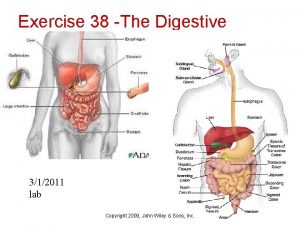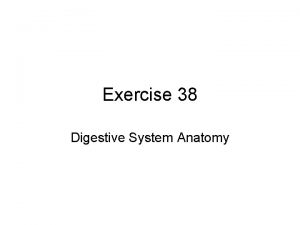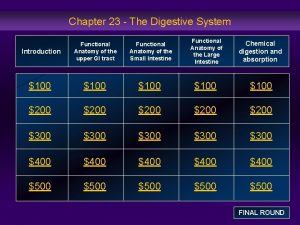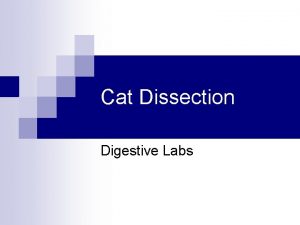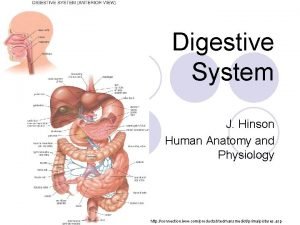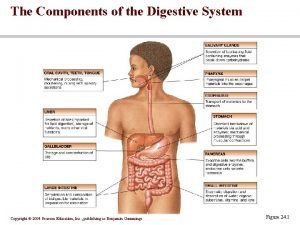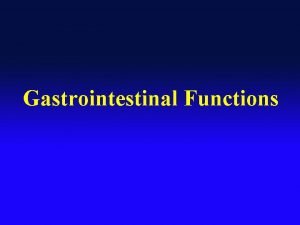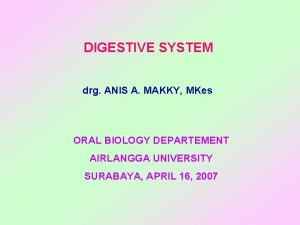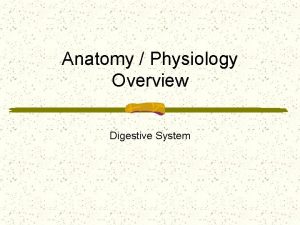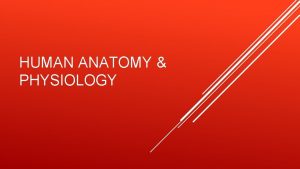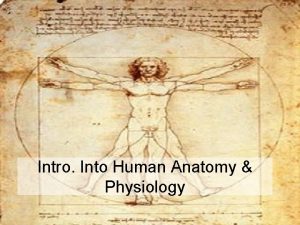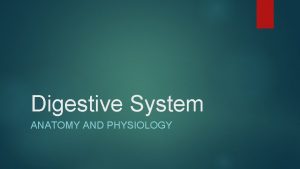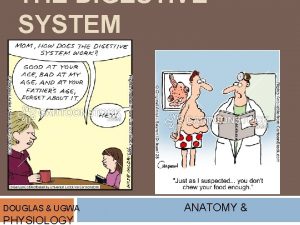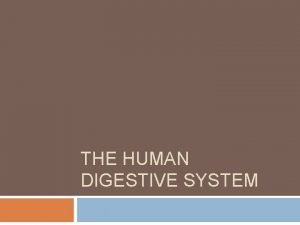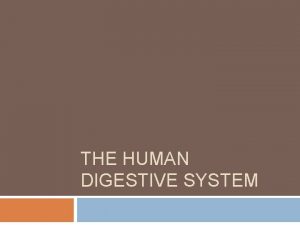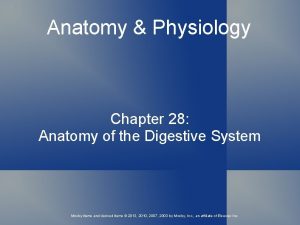Digestive System Human Anatomy Physiology Chapter 15 Digestive










































- Slides: 42

Digestive System Human Anatomy & Physiology Chapter 15

Digestive System Function 1. Ingest Food 2. Break down food into small molecules that can cross cell membranes 3. Nutrient absorption 4. Eliminate nondigestible wastes

Gastrointestinal (Gl) tract • Direct path between organs • Structures included: 1. 2. 3. 4. 5. 6. 7. Mouth Pharynx Esophagus Stomach Small intestine Large Intestine Rectum

Digestive (GI) Tract

Action Terms of Digestive (GI) Tract • Ingestion – Occurs when material enters via the mouth • Mechanical Processing • Secretion – Release of water acids, buffers, enzymes & salts by epithelium of GI tract and glandular organs – Crushing / Shearing – makes material easier to move through the tract • Absorption – Chemical breakdown of food into small organic compounds for absorption • Excretion • Digestion – Movement of organic substrates, electrolytes, vitamins & water across digestive epithelium – Removal of waste products from body fluids

Digestion • Digestive Enzymes – Break molecular bonds in large organic molecules • Carbohydrates, proteins, lipids, and nucleic acids • In a process called hydrolysis – Are divided into classes by targets • Carbohydrases break bonds between simple sugars • Proteases break bonds between amino acids • Lipases separate fatty acids from glycerides


Histological Structure of the Digestive (GI) Tract

Movement of Digestive Materials • There are muscular layers of digestive tract – Consist of smooth muscle – Along digestive tract: • PERISTALSIS - rhythmic cycles of activities – Consists of waves of muscular contractions • Controlled by pacesetter cells • Cells undergo spontaneous depolarization – Triggering wave of contraction through entire muscular sheet

Peristalsis

Mouth & Pharynx • Sensory analysis – Of material before swallowing • Mechanical processing – Through actions of teeth, tongue, and palatal surfaces • Adding Fluids – Mixing with mucus and salivary gland secretions • Limited digestion – Of carbohydrates and lipids

Esophagus • A hollow muscular tube • About 25 cm (10 in. ) long and 2 cm (0. 80 in. ) wide • Secretes mucus • Conveys solid food and liquids to the stomach • If acid from the stomach backs up it causes “heartburn”.

Stomach • Major Functions of the Stomach – Storage of ingested food – Breakdown of ingested food – Disruption of chemical bonds in food material by acid and enzymes – Produce Hydrochloric Acid (HCl) to kill bacteria – Production of intrinsic factor, a glycoprotein required for absorption of vitamin B 12 in small intestine

Gastric Anatomy

Digestion in the Stomach • Stomach performs preliminary digestion of proteins by pepsin – Some digestion of carbohydrates (by enzyme amylase) and lipids (by enzyme lipase) • Stomach contents – Become more fluid – p. H approaches 2. 0 – Pepsin activity increases • ***Although digestion occurs in the stomach, nutrients are not absorbed there

Small Intestine • 90% of absorption occurs in the small intestine

Small Intestine • The Duodenum – The segment of small intestine closest to stomach – “Mixing bowl” that receives chyme from stomach and digestive secretions from pancreas and liver – Neutralizes acids before they can damage the absorptive surfaces of the small intestine

Small Intestine • The Jejunum – Is the middle segment of small intestine – 2. 5 meters (8. 2 ft) long – Is the location of most • Chemical digestion • Nutrient absorption

Small Intestine • The Ileum – The final segment of small intestine – 3. 5 meters (11. 48 ft) long – Ends at the ileocecal valve, a sphincter that controls flow of material from the ileum into the large intestine • Intestinal Absorption takes about 5 hours for materials to pass from duodenum to end of ileum

Small Intestine

Large Intestine • Is horseshoe shaped • Extends from end of ileum to anus • Lies inferior to stomach and liver • Frames the small intestine • Also called large bowel • Is about 1. 5 meters (4. 9 ft) long and 7. 5 cm (3 in. ) wide

Large Intestine Functions – Reabsorption of water – Compaction of intestinal contents into feces – Absorption of important vitamins produced by bacteria – Storage of fecal material prior to defecation

Parts of Large Intestine • The Cecum – Is an expanded pouch – Receives material arriving from the ileum – Stores materials and begins compaction • Appendix – Is a slender, hollow appendage about 9 cm (3. 6 in. ) long – Is dominated by lymph tissue

Parts of Large Intestine • The Colon – Has a larger diameter and thinner wall than small intestine – The wall of the colon • Forms a series of pouches (haustra) – Haustra permit expansion and elongation of colon

Parts of Colon

Physiology of the Large Intestine • Absorption in the Large Intestine – Reabsorption of water – Reabsorption of bile salts • In the cecum • Transported in blood to liver – Absorption of vitamins produced by bacteria – Absorption of organic wastes

Physiology of the Large Intestine Three Vitamins Produced in the Large Intestine 1. Vitamin K (fat soluble): • Required by liver 2. Biotin (water soluble): • Important in glucose metabolism 3. Pantothenic acid: B 5 (water soluble): • Required for hormones and neurons

Physiology of the Large Intestine • Organic Wastes – Bacteria break down peptides in feces and generate • Ammonia, Indole & skatole, hydrogen sulfide – Bacteria feed on indigestible carbohydrates (complex polysaccharides)

Rectum • The Rectum – Forms last 15 cm (6 in. ) of digestive tract – Is expandable for temporary storage of feces – Movement of fecal material into rectum triggers urge to defecate • The Anus is the exit orfice

Accessory Digestive Organs • Organs that are not part of the pathway but aid in the digestion and absorption process • Includes: – Pancreas – Liver – Gall Bladder

Pancreas • Lies posterior to stomach – From duodenum toward spleen • Functions of the Pancreas 1. Secrete - insulin and glucagon into bloodstream 2. Exocrine cells: - cells of duct system secrete an array of enzymes

Liver

Liver • Hepatocytes – Are liver cells – Adjust circulating levels of nutrients – As blood flows through • Hepatocytes absorb solutes from plasma • And secrete materials such as plasma proteins

Liver Function The Physiology of the Liver 1. Metabolic regulation 2. Hematological regulation 3. Bile production Bile – aids in the digestion of lipids

Liver Function • Metabolic Regulation – The liver regulates: 1. Composition of circulating blood 2. Nutrient metabolism (carbohydrate, lipid & amino acid) 3. Waste product removal 4. Vitamin Storage (A, D, E & K) 5. Nutrient storage (iron) 6. Drug inactivation

Liver Function • Hematological Regulation – Largest blood reservoir in the body • Receives 25% of cardiac output • Functions of Hematological Regulation 1. 2. 3. 4. 5. Synthesis of plasma proteins Removal of circulating hormones Removal of antibodies Removal or storage of toxins Synthesis and secretion of bile

Liver

Gallbladder • Is a pear-shaped, muscular sac • Stores and concentrates bile prior to excretion into small intestine • Is located on the posterior surface of the liver’s right lobe • The Cystic Duct – Extends from gallbladder – Union with common hepatic duct forms common bile duct

Ducts

Gallbladder • Functions of the Gallbladder – Stores bile – Releases bile into duodenum, but only under stimulation of hormone cholecystokinin (CCK) • Fatty diets can cause gallstones

Fetal Pig Anatomy • https: //www. youtube. com/watch? v=8 RWs. Qvl T 3 bo

 Chapter 1 introduction to human anatomy and physiology
Chapter 1 introduction to human anatomy and physiology Anterior posterior distal proximal
Anterior posterior distal proximal Chapter 2 human reproductive anatomy and physiology
Chapter 2 human reproductive anatomy and physiology Male vs female skeleton pelvis
Male vs female skeleton pelvis Endomysium
Endomysium Holes essential of human anatomy and physiology
Holes essential of human anatomy and physiology Paratubular cyst
Paratubular cyst Anatomy and physiology ninth edition
Anatomy and physiology ninth edition Anatomy and physiology unit 7 cardiovascular system
Anatomy and physiology unit 7 cardiovascular system Types of respiration in human
Types of respiration in human Chapter 14 anatomy and physiology
Chapter 14 anatomy and physiology Anatomy and physiology chapter 8 special senses
Anatomy and physiology chapter 8 special senses Chapter 13 anatomy and physiology of pregnancy
Chapter 13 anatomy and physiology of pregnancy Anatomy and physiology chapter 2
Anatomy and physiology chapter 2 Anatomy and physiology chapter 7
Anatomy and physiology chapter 7 Art labeling activity: figure 14.1 (3 of 3)
Art labeling activity: figure 14.1 (3 of 3) Chapter 10 blood anatomy and physiology
Chapter 10 blood anatomy and physiology Anatomy and physiology chapter 15
Anatomy and physiology chapter 15 Necessary life functions anatomy and physiology
Necessary life functions anatomy and physiology Holes anatomy and physiology chapter 1
Holes anatomy and physiology chapter 1 Anatomy and physiology chapter 15
Anatomy and physiology chapter 15 Chapter 6 general anatomy and physiology
Chapter 6 general anatomy and physiology Cranial cephalic
Cranial cephalic Exercise 38
Exercise 38 Exercise 38
Exercise 38 Functional anatomy of the digestive system
Functional anatomy of the digestive system Cat
Cat Mucus c
Mucus c Intestine histology
Intestine histology Protein absorption
Protein absorption Parasimpathetic
Parasimpathetic Respiratory digestive and circulatory system
Respiratory digestive and circulatory system The upper respiratory tract
The upper respiratory tract Tattoo anatomy and physiology
Tattoo anatomy and physiology International anatomy olympiad
International anatomy olympiad External parts of a leaf
External parts of a leaf Anatomy and physiology of bone
Anatomy and physiology of bone Peptic ulcer anatomy
Peptic ulcer anatomy Liver anatomy
Liver anatomy Difference between anatomy and physiology
Difference between anatomy and physiology Epigastric region
Epigastric region Blood in anatomy and physiology
Blood in anatomy and physiology Http://anatomy and physiology
Http://anatomy and physiology























